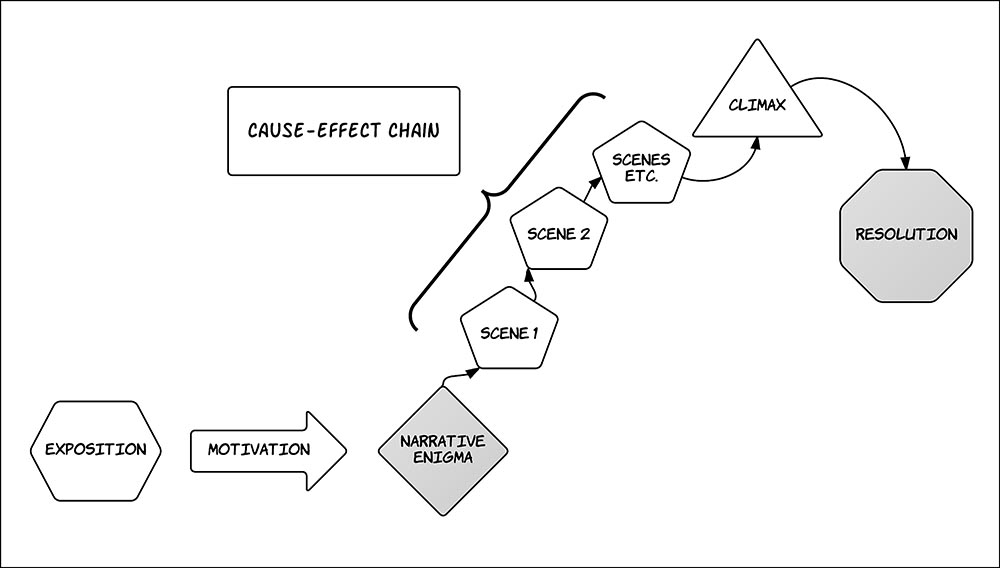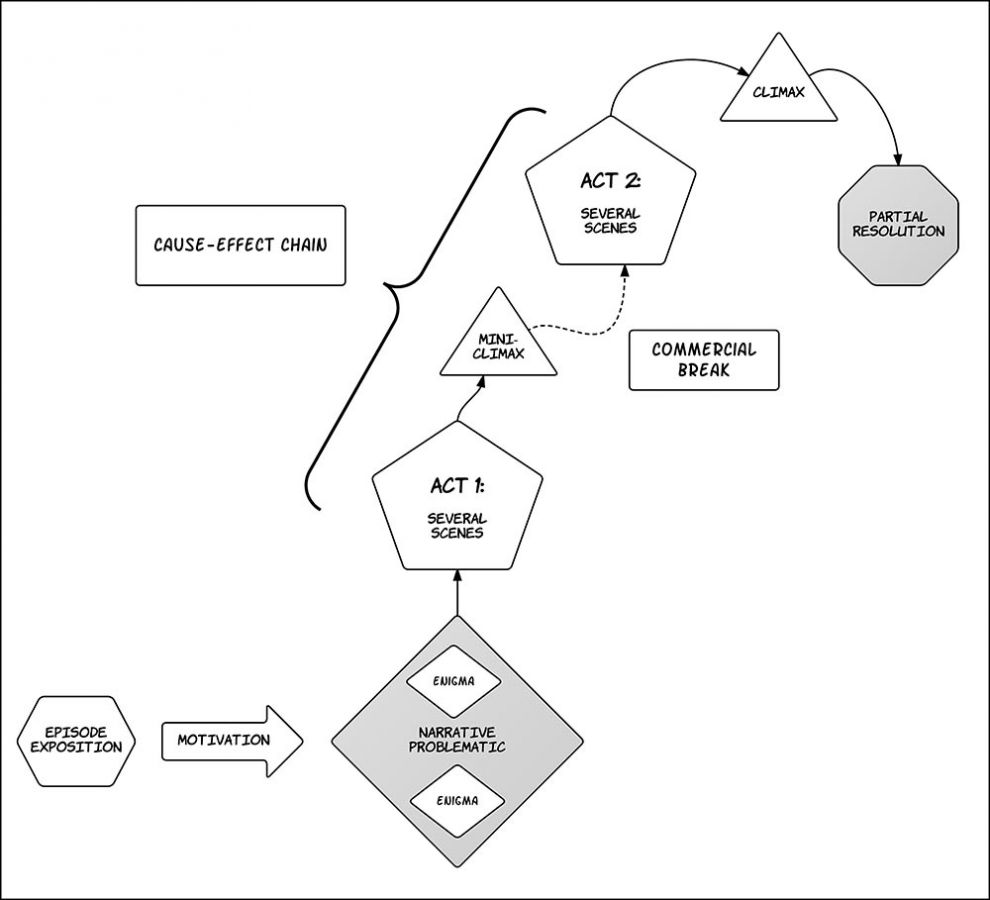|
|
| Line 1: |
Line 1: |
| − | =="The Evolution of Film Language"== | + | ==Classical Hollywood cinema== |
| − | #'''Group 3:''' Bazin sees two broad and opposing trends in the cinema between 1920 and 1940: "those directors who believed in the image and those who believed in reality." What does Bazin mean by "believed in reality"? To which early, 1890s filmmakers might we trace this tendency?
| + | <gallery mode="packed" heights=600px> |
| − | #'''Group 4:''' Bazin sees two broad and opposing trends in the cinema between 1920 and 1940: "those directors who believed in the image and those who believed in reality." Bazin says the "believed in the image" directors can be "traced back to two factors." What are they? How does a Russian film movement exemplify ''one'' of these factors? To which early 1900s filmmaker might we trace this tendency?
| + | File:Narrative Structure - Classical Film.jpeg|alt=Diagram of classical narrative structure.|''Television'' Figure 3.6 The rise and fall of the narrative action in classical film. |
| − | #'''Group 5 & 2:''' Bazin contends that "analytic" or "dramatic" editing (i.e., "shooting script") was "strongly challenged by the technique of composition in depth used by Orson Welles and William Wyler." What is '''composition in depth'''? What are some examples from Welles's, Wyler's and/or Renoir's work? How does composition in depth "demand a more active mental attitude" and "bring ambiguity back into the structure of the image"?
| + | </gallery> |
| − | #*You can find more examples here: [http://www.tcf.ua.edu/Classes/Jbutler/T340/Bazin02.php tcf.ua.edu/Classes/Jbutler/T340/Bazin02.php]
| |
| − | #*[[File:BestYears01.jpg]]
| |
| − | #'''Group 6 & 1:''' Bazin claims Renoir is "the only director who consistently, attempted in his films up to ''La Règle du Jeu'' [''Rules of the Game''] to rise above facile editing effects and seize the secret of a cinematic style which was capable of expressing everything without fragmenting the world, of revealing the hidden meaning of human beings and their environment without destroying their natural unity" (48). Do you agree that Renoir's style does not "fragment the world"? Why or why not?
| |
| − | #*Note the camera movement in the "Dance Macabre" segment of ''Rules of the Game'': [http://www.tcf.ua.edu/EO/DV/RulesOfTheGame_Masquerade.php http://www.tcf.ua.edu/EO/DV/RulesOfTheGame_Masquerade.php]
| |
| − | #**http://www.tcf.ua.edu/Classes/Jbutler/T340/RulesOfTheGame/Rules_13.jpg
| |
| | | | |
| − | {{Gallery
| + | Does ''Always Be My Maybe'' fit the classical implementation of: |
| − | |title=''Rules of the Game''
| |
| − | |height=300
| |
| − | |width=400
| |
| − | |lines=1
| |
| − | |align=center
| |
| − | |File:Rules of the Game Relationship Chart 20181001 - signed.jpg|alt3=Rules of the Game relationship chart.|Relationship chart.
| |
| − | }}
| |
| | | | |
| − | =="The Era of the Popular Front."==
| + | #Single protagonist |
| − | #'''All Groups:''' Bazin maintains that the camera movement when Batala is murdered at the end of ''The Crime of M. Lange'' ([https://tcf.ua.edu/Classes/Jbutler/T340/CrimeOfMLangeBatalasDeath.php see images online]) "is the pure spatial expression of the entire mise-en-scene". What do you think Bazin means by this? How is he using the term "mise-en-scene" (is it the same as in ''Television''?)? | + | #Exposition |
| − | #*Hint: remember the original scenario for the film was titled, ''On the Courtyard''. | + | #Motivation |
| − | #**See also, [http://www.tcf.ua.edu/EO/DV/GrandIllusion_Marseillaise.php the ''Grand Illusion'' shot of POWs singing "La Marseillaise"].
| + | #Narrative enigma |
| − | #'''All Groups:''' What error does Bazin make in describing the shot he diagrams? | + | #Cause-effect chain |
| | + | #*''Story time'' versus ''screen time''--in terms of duration and order |
| | + | #Climax |
| | + | #Resolution |
| | | | |
| − | [[File:Bazin CrimeDiagram.jpg]]
| + | ==The television series== |
| | | | |
| − | {{Gallery
| + | <gallery mode="packed" heights=600px> |
| − | |title=''Grand Illusion'': "La Marseillaise" ([http://www.tcf.ua.edu/EO/DV/GrandIllusion_Marseillaise.php view clip])
| + | File:Fig03-12 TV Series Narrative Structure - rendered.jpg|alt=Diagram of series-TV narrative structure.|''Television'' Figure 3.12 Linear-TV series' narrative structure must accommodate commercial interruptions and allow for a repeatable narrative problematic. |
| − | |height=300
| + | </gallery> |
| − | |width=400
| |
| − | |lines=1
| |
| − | |align=center
| |
| − | |File:GrandIllusion 00 40 00.jpg|alt1=Grand Illusion, first frame.|First frame of shot.
| |
| − | |File:GrandIllusion 00 41 00.jpg|alt2=Grand Illusion, last frame.|Last frame. | |
| − | }}
| |
| | | | |
| − | ==Bazinian exercise==
| + | Break down the "The Vartabedian Conundrum" episode from ''The Big Bang Theory'' (December 8, 2008). Number each scene and provide a ''brief'' description of it. |
| − | Each group will visualize ''two versions'' of a simple narrative scene. After you decide how you will do the two versions, divide your group in half to work on the two versions. Further subdivide the work and (if you have enough in your group) have one person do a shot list, one do a camera diagram, and one do a storyboard.
| + | *How many scenes does it have? |
| − | ===Version 1===
| |
| − | #List a minimum of six shots from the scene, as it might be done using classical editing (Bazin's "analytic" editing). Use conventions like establishing shots and shot-counter shot. Specify the framing of each shot (close-up, long shot, etc.) Type it in a word processor.
| |
| − | #Draw an overhead camera diagram as we did for our scene breakdowns and Bazin did for ''The Crime of M. Lange''.
| |
| − | #Draw a storyboard of your shots.
| |
| − | #Take photographs of the diagram and storyboard and email them with your shotlist to jbutler@ua.edu .
| |
| − | ===Version 2===
| |
| − | Rework the same scene as Renoir might have done it, using composition in depth and lateral camera movement, but telling the same story. How many shots would you use to replicate Renoir's style?
| |
| − | #List your shots (type it in a word processor)
| |
| − | #Draw an overhead camera diagram.
| |
| − | #Draw a storyboard of your shots. If you have a shot with camera movement, draw more than one frame to represent it.
| |
| − | #Take photographs of the diagram and storyboard and email them with your shotlist to jbutler@ua.edu .
| |
| | | | |
| − | ===The narrative scene===
| + | Does the episode contain the conventional elements of a TV series? What are the key differences between its narrative structure and that of a classical film? |
| − | *Two students are working together, editing a video in a computer lab that has a "no food" policy. One of them has smuggled a cookie into the lab. He/she breaks it in half and shares it with the other student. They then snicker at the lab attendant, who doesn't realize that food has been brought into the lab. [What happens next is up to you.]
| + | #Multiple protagonists |
| | + | #Exposition |
| | + | #Motivation |
| | + | #Narrative problematic |
| | + | #Cause-effect chain |
| | + | #Climax |
| | + | #Resolution? |
| | | | |
| − | ===Extra credit option===
| + | [[Category:BUI301F2022]] |
| − | *May be done with your JCM 312 group or on your own.
| + | [[Category:BUI301F2022 Discussion]] |
| − | *Shoot two versions of a scene (doesn't have to be the scene above): one using classical editing; the other using Bazinian realism.
| |
| − | *Two minutes maximum for each video.
| |
| − | *Upload them somewhere and send links to jbutler@ua.edu.
| |
| − | *Due Wednesday, October 10th.
| |
| − | *Worth 3 extra credit points.
| |
| − | *Fall 2018 Submissions:
| |
| − | **[https://youtu.be/Cj7nez_Ei-w Group One]
| |
| − | **[https://tcf.ua.edu/EO/DV/Bazin%20Exercise_Group6.php Group Six]
| |
| − | <!--
| |
| − | {{Gallery
| |
| − | |title=Bazin/Renoir Editing Exercise
| |
| − | |height=300
| |
| − | |width=400
| |
| − | |lines=1
| |
| − | |align=center
| |
| − | |File:|alt3=Group 1, 6-shot.|Group 1, 6-shot.
| |
| − | |File:|alt4=Group 1, Renoir-style.|Group 1, Renoir-style.
| |
| − | |File:|alt5=Group 2, 6-shot.|Group 2, 6-shot.
| |
| − | |File:|alt6=Group 2, Renoir-style.|Group 2, Renoir-style.
| |
| − | |File:|alt7=Group 3, 6-shot.|Group 3, 6-shot.
| |
| − | |File:|alt8=Group 3, Renoir-style.|Group 3, Renoir-style.
| |
| − | |File:|alt9=Group 4, 6-shot.|Group 4, 6-shot.
| |
| − | |File:|alt10=Group 4, Renoir-style.|Group 4, Renoir-style.
| |
| − | }}
| |
| − | -->
| |
| − | | |
| − | ==Additional resources==
| |
| − | *[https://tcf.ua.edu/Classes/Jbutler/T340/RulesOfTheGame/Rules%20of%20the%20Game%20Relationship%20Chart%2020181001%20-%20signed.jpg ''Rules of the Game'' Relationship Chart]
| |
| − | **[https://tcf.ua.edu/Classes/Jbutler/T340/RulesOfTheGame/Rules%20of%20the%20Game%20Relationship%20Chart%2020181001%20-%20signed.pdf ''Rules of the Game'' Relationship Chart--PDF version for printing]
| |
| − | | |
| − | ==Bibliography==
| |
| − | *Bazin, André. "The Evolution of Film Language." In ''The New Wave'', pp. 24-51. Edited and translated by Peter Graham. Garden City, NY: Doubleday, 1968.
| |
| − | *Bazin, André. "The Era of the Popular Front." In ''Jean Renoir'', pp. 36-52. Edited and with an introduction by Francois Truffaut. Translated by W. W. Halsey II and William H. Simon. NY: Simon & Schuster, 1973.
| |
| − | | |
| − | [[Category:JCM312 Discussion]] | |

